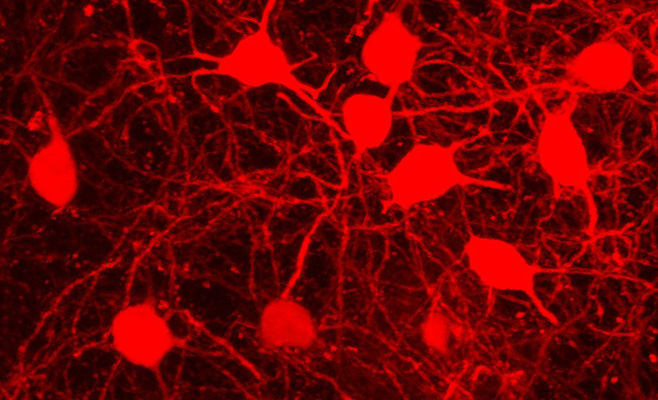New Way Found to Control Motor Symptoms Associated to Advanced Parkinson's Disease

Taking the standard medications for the treatment of Parkinson's diseases for a prolonged period of time could result in certain motor complications that could affect the mobility of the patient. Abnormal involuntary movements, also called dyskinesias, are one of the complications experienced by the patients. A Parkinson's nonhuman primate model by the scientists of Emory University has immensely helped in figuring out the origin of such abnormal responses experienced by patients suffering from Parkinson's disease.
The results that seem to be extremely useful in the development of new treatment options have been published in a journal called Cell Reports.
Neuroscientists believe that the origin of the abnormal involuntary movements is due to an imbalance in the dopamine levels in the body. Dopamine is a type of neuronal messenger or neurotransmitter that transfers messages from one neuron to the other. People who are suffering from Parkinson's disease have lost the production of dopamine in their brains. A drug administered to the patients helps in restoring the dopamine imbalance. But, at certain situations in the process of providing relief, the levels could hike resulting in unstable responses by the patient.
Stella Papa led the team of researchers and showed that striatal projection neurons (SPN) become hyperactive at the time when the neurons known for producing dopamine degenerate. There is a possibility to control this response using certain drugs that reduce the rate of the responses resulting in dyskinesias. The basal ganglia constitute striatum, one of the major brain areas affected by Parkinson's disease.
Papa from the Emory University School of Medicine mentioned that the focus of the study was to prove that SPN hyperactive has a major role which is contributed by glutamate signals. After knowing this mechanism, researchers can create new therapeutic strategies for the treatment of Parkinson's disease which includes gene therapies and pharmacological treatments.
The paper's first author of the publication was Arun Singh from the University of Iowa. The laboratories belonging to the Emory's Department of Pharmacology contributed immensely to this study, including Stephen Traynelis' group. Dr. Traynelis played an important part in the study. Annalisa Scimemi in SUNY Albani was also known for making contributions.
The researchers of the study made a point to test NBQX (a type of AMPA receptor antagonist) and LY235959 (a type of NMDA receptor antagonist) for controlling the SPN hyperactivity along with the dyskinesia symptoms that were observed in the monkey test subjects. The Parkinson's nonhuman primate model utilizes neurotoxin MPTP, known for destroying dopamine-producing neurons.
Both the drugs were found to interfere with the signals transmitted by the neurotransmitter glutamate. If levodopa was present, the drugs created a calming effect in case of SPN recordings and when the drugs were administered to the basal ganglia of the monkeys. When the SPN firing frequency was lowered by 50 percent, the dopamine response stabilized and the abnormal movements also reduced, according to Papa.
She also noted that certain drugs may not be useful for humans, but they are capable of revealing the mechanism running behind the abnormal involuntary movements. Such insights are helpful in developing better treatments for people suffering from Parkinson's disease.
What is Striatal Projection Neurons?
Striatal projection neurons, also known as medium spiny neurons (MSNs), are a type of neuron found in the striatum, a region of the brain that is part of the basal ganglia. The striatum plays a crucial role in various motor and cognitive functions, including motor control, learning, and decision-making.
Here are some key characteristics and functions of striatal projection neurons:
- Striatal projection neurons can be divided into two main types based on their projections and neurotransmitter release: those that release dopamine (D1 receptor-expressing MSNs) and those that release gamma-aminobutyric acid (GABA) (D2 receptor-expressing MSNs). These two types have different functional roles and contribute to the balance of excitatory and inhibitory signals within the striatum.
- Striatal projection neurons are crucial for regulating voluntary movements. They receive input from various regions of the brain, including the cortex, thalamus, and substantia nigra, and integrate this information to influence motor behavior.
- The striatum is involved in reward processing and reinforcement learning. Dopamine-releasing MSNs are particularly important in this regard, as they play a role in encoding the reward prediction error, a key signal in reinforcement learning.
- Striatal projection neurons are involved in procedural learning, habit formation, and skill acquisition. They help establish the neural circuits that underlie these processes.
- Dysfunction of striatal projection neurons is implicated in various neurological and neuropsychiatric disorders. For example, in Parkinson's disease, there is degeneration of dopaminergic neurons projecting to the striatum, leading to motor symptoms. In conditions like Huntington's disease, there is selective degeneration of striatal projection neurons.
- The balance between the two types of striatal projection neurons (D1 and D2 receptor-expressing) and their activity levels is critical for normal motor function and behavior. Dysregulation of this balance can lead to movement disorders and other neurological issues.
- Research into striatal projection neurons and their roles in brain function and dysfunction is ongoing, as understanding these neurons is essential for developing treatments for various neurological and psychiatric conditions.